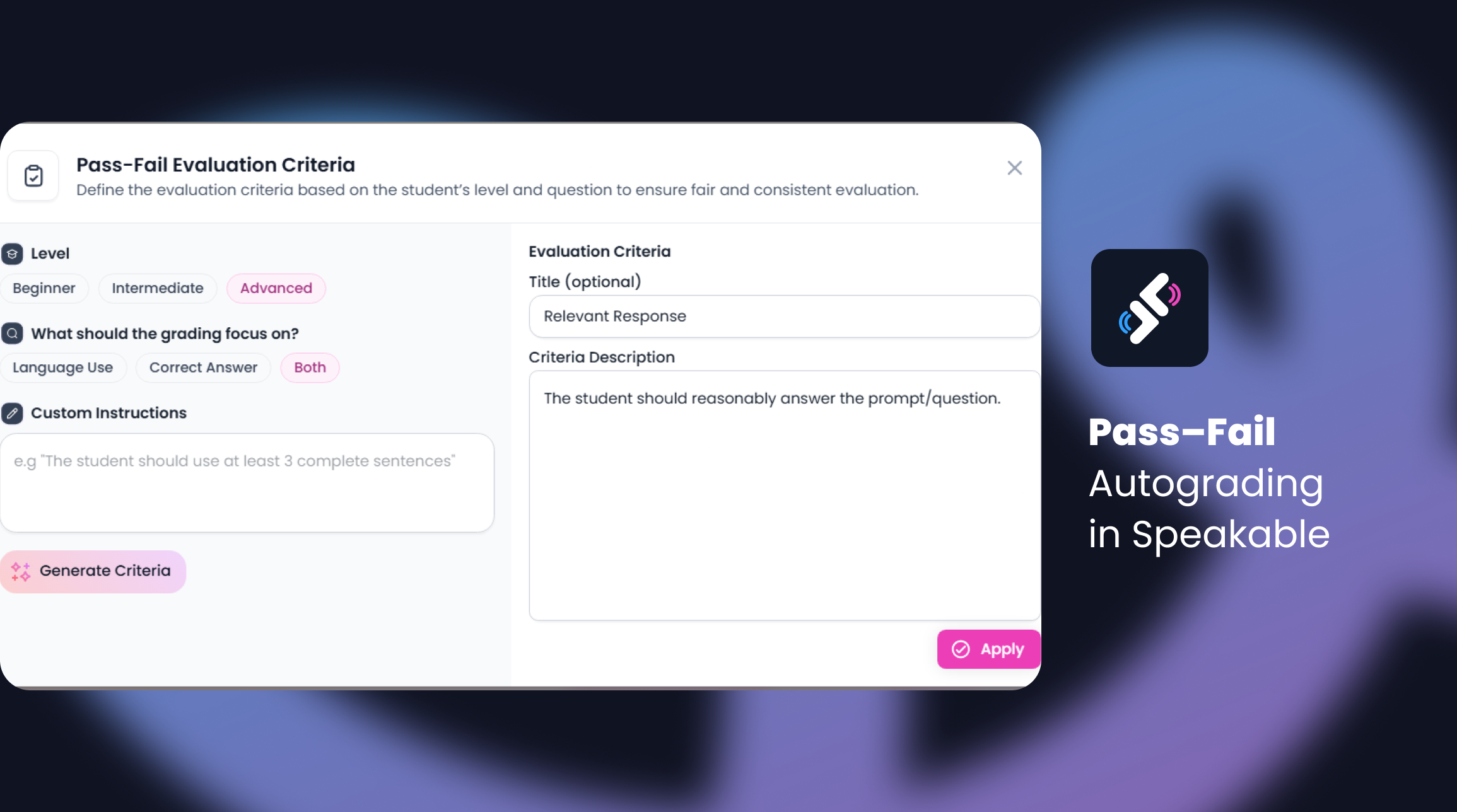
When students submit a spoken or written open response in Speakable, pass–fail autograding helps you check work quickly and consistently. It shows whether a student met the expectations you set and returns short, clear feedback right away.
It’s perfect for everyday checks:
Did the student answer the question? In the target language? With enough detail to show understanding?
Note on speech: Speakable transcribes student speech before grading. Pass-Fail does not evaluate pronunciation or fluency. Use it to check what was communicated (task completion, vocabulary, accuracy), not how it sounded.
Need proficiency bands?
Use Standards-Based Grading with ACTFL or WIDA for performance levels like Novice, Intermediate, or Advanced. That mode is built for proficiency reporting.
💡 Tip: Make criteria observable and countable. For example: “uses 3 target words,” “includes 2 past-tense verbs,” or “cites 2 details.”
Each template includes a Title and Criteria. Paste them into the “Evaluation Criteria” field and adjust for your task.
1. Task Completion & Relevance
Criteria: Pass if the response answers all parts of the prompt, stays on topic, and is in the target language. Fail if any part is missing, off-topic, or not in the target language.
2. Comprehensibility & Coherence
Criteria: Pass if meaning is clear to a sympathetic reader or listener and ideas follow a logical order (beginning → details → closing). Fail if disorganization or unclear wording affects understanding.
3. Target Vocabulary Coverage
Criteria: Pass if the response correctly uses at least {k} target terms: {enter_required_terms}. Fail if fewer than {k} are used or usage shows misunderstanding.
4. Language Control (Grammar or Structures)
Criteria: Pass if the response accurately uses the target structure(s) {list_structures} and errors do not impede meaning. Fail if structures are missing or errors often obscure meaning.
5. Organization & Cohesion
Criteria: Pass if ideas follow a logical order and use connectors (for example, first, then, because, however). Fail if the response is list-like or lacks transitions.
6. Interpretive Evidence Use
Criteria: Pass if the response includes {n} accurate details from the source and one supported inference (if required). Fail if details are inaccurate, insufficient, or unsupported.
7. Cultural Comparison
Criteria: Pass if the response discusses both cultures, includes {n} examples for each, and makes {m} comparisons. Fail if it covers only one culture or lacks comparative points.
8. Targeted Form & Function
Criteria: Pass if the response (a) fulfills the communicative function {for example, request information or narrate a past event} and (b) includes the target form {for example, past tense or formal register} in at least {x} places. Fail if either condition is unmet.
Use This: Pass–Fail Autograding
When Your Goal Is: Quick, criterion-based checks for a single task
Use This: Standards-Based Grading (ACTFL/WIDA)
When Your Goal Is: Measuring performance across proficiency levels
Is pass–fail only for summative grades?
No. It’s ideal for practice, formative checks, and exit tickets, any time you want fast, consistent feedback without a full rubric.
Can I still leave comments?
Yes. Speakable provides a Pass-Fail decision with short feedback. You can add your own notes anytime.
Any tips for best results?
Keep criteria specific and countable. Combine two criteria for more depth (like “Task Completion” and “Vocabulary Coverage”). Show students examples so they know what success looks like.
Create a Spoken or Written Open Response in Speakable, paste one of the templates into Evaluation Criteria, tweak the brackets, and assign. You’ll get fast, consistent checks, and students will know exactly what to improve next.